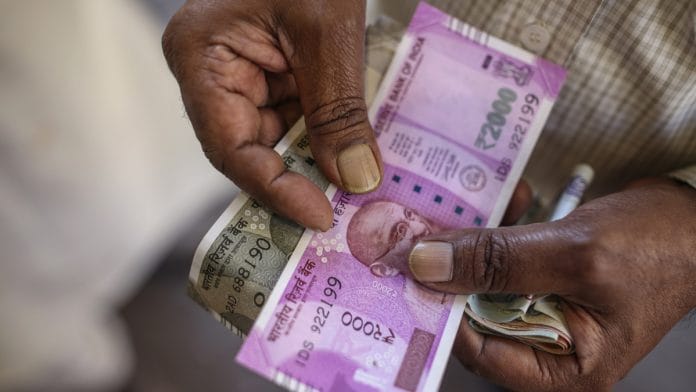New Delhi: Faced with a sharp contraction in revenues accompanied by an increase in expenditure to battle the Covid-19 pandemic, many Indian states have been forced to borrow at substantially higher interest rates from the market.
This comes at a time when the Reserve Bank of India (RBI) has sharply cut interest rates to fight the pandemic. The repo rate or the rate at which banks borrow from RBI is as low as 4.4 per cent right now.
Data from the RBI shows the average yield on state government borrowings was around 7.7-8 per cent. The yield on the benchmark 10-year paper or the rate at which the central government borrows from the market was 6.46 per cent. This means the state governments are borrowing at an interest rate at least 1.3 percentage points higher than what the Centre’s interest cost is.
Analysts point out that higher yields can be attributed to the fact that the markets expect the states and the Centre to borrow more than what has been budgeted due to the sharp increase in expenditures arising out of Covid-19.
Soumyajit Niyogi, associate director at India Ratings and Research, said the bond markets expect the central and state governments to borrow more on account of the cash crunch from a fall in revenues and increase in expenditure, which is pushing up bond yields.
“Due to the expectation that the government will borrow more this year, 10-year g-sec (government securities) yield has increased to 6.4 per cent. Typically, state governments are able to borrow at 30-50 basis points higher than the g-sec yield. But during a crisis or uncertain times, the borrowing costs for states increases and this spread increases. This is what is happening now with spreads much over 100 basis points,” he said.
Niyogi said state governments have little choice but to raise money from the markets as they have limited sources of revenue. He added that typically state governments borrow less in the first half of the fiscal year but that is likely to change this year.
Also read: Economists expect RBI will print money as India battles Covid-19. Here’s what it means
Borrowings by states
To counter cash flow problems, state governments have borrowed more than Rs 44,000 crore in the first two weeks of April, according to the RBI data.
As many as 19 Indian states, including Maharashtra, Kerala, Tamil Nadu, Karnataka, Haryana, Gujarat and Madhya Pradesh, borrowed Rs 32,560 crore from the markets on 7 April, with the weighted average yield on the 10-year papers at around 7.7-8 per cent across states.
The yields lowered marginally to 7.6-7.7 per cent when nine of these states borrowed around Rs 12,000 crore on 13 April, the data showed.
State governments have been allowed to borrow a total of Rs 3.2 lakh crore in the April-December period by the central government.
The higher yields on state government borrowings is in complete contrast with the yields movement in 2019-20 when weighted average yields on state development loans had fallen from around 8.2 per cent to around 7.2 per cent.
State governments saw their borrowing costs increasing in March itself when yields had started to rise.
Also read: Govt studying Covid-19 impact for fiscal stimulus package: CEA Krishnamurthy Subramanian
Calls for ignoring FRBM rules
On Friday, the RBI increased the limit for states to borrow under ways and means advances by 60 per cent over March 2020 levels. This will be allowed until September and “provide greater comfort to the states for undertaking COVID-19 containment and mitigation efforts, and to plan their market borrowing programmes better”, said the bank.
The move came even as states expressed concerns about their rising borrowing costs. Bihar Deputy Chief Minister Sushil Modi told ThePrint in an interview this week that fiscal uncertainty has compounded due to coronavirus, and “states are borrowing at higher rates from the market”.
“The borrowing rate has increased, and there are fewer buyers for state bonds,” he said, adding that the RBI should start purchasing state bonds.
On 10 April, Kerala Finance Minister Thomas Isaac cited the wide difference between repo rates and the yields on state development loans to seek monetisation of deficit by way of the central government overlooking Fiscal Responsibility and Budget Management (FRBM) Act rules and directly borrowing from the central bank.
RBI reduces the repo rate to 4.4 % but the coupon rate for 15 year Kerala SLR bonds bid by the banks is 8.96% .It is high time India Government follow the course adopted by all major economies for stimulus- borrow directly from the Central Bank and for the time ignore FRBM rules.
— Thomas Isaac (@drthomasisaac) April 10, 2020
Speaking at a seminar Tuesday, HDFC chairman Deepak Parekh made a similar case. He pointed out how yields have risen and not fallen despite repo rate cuts by RBI. Parekh recommended that the central bank should directly purchase corporate bonds and commercial papers as primary markets have died down. Globally all countries are doing it in order to fund economic activity, he added.
HDFC has announced its plans to raise funds at a 7.2 per cent coupon rate.
Indian states that are at the forefront of the battle against Covid-19 have asked the Centre for greater financial support, including release of financial grants due to states ahead of schedule, allowing them to borrow more and relaxing the 3 per cent cap on fiscal deficit as a percentage of GDP, and timely payment of goods and services tax (GST) compensation.
The central government on its part has acceded to some of the demands. It released GST compensation to the states for the months of October and November amounting to Rs 14,103 crore. It also released Rs 17,287 crore to states under various heads to help battle Covid-19.
Also read: Govt package a relief measure, tax-break stimulus ideal to fight Covid: RBI panel member






